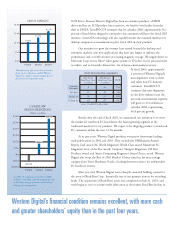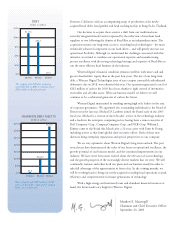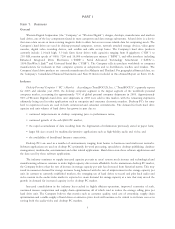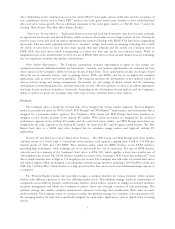Western Digital 2003 Annual Report Download - page 13
Download and view the complete annual report
Please find page 13 of the 2003 Western Digital annual report below. You can navigate through the pages in the report by either clicking on the pages listed below, or by using the keyword search tool below to find specific information within the annual report.Industry standard interfaces are utilized to allow the disk drive to communicate with the computer. Currently, the
primary interface for desktop PC's is EIDE, and the primary interface for enterprise systems is SCSI. As computer
performance continues to improve, the hard drive will need to deliver information faster than these interfaces can handle.
The Company believes that the desktop PC industry plans to transition to higher speed interfaces, such as SATA, to
handle the higher data transfer rates. The Company currently oÅers its WD Caviar Special Edition SATA hard drive, a
7200 RPM drive featuring capacities as large as 250 GB and designed for the high-end PC, workstation and entry-level
server markets. The Company believes that SATA is also becoming a more popular interface in the enterprise market.
Western Digital currently oÅers its WD Raptor hard drive, a 10,000 RPM enterprise-class drive with the SATA
interface. The Company is working to develop additional products that will support these higher speed interfaces.
Storage capacity of the hard drive is determined by the number of disks and each disk's areal density, which is a
measure of the amount of data that can be stored on the recording surface of the disk. Areal density is generally measured
in megabits per square inch of disk surface. The higher the areal density, the more information can be stored on a single
platter. As the areal density increases, fewer disks and/or heads are required to achieve a given drive capacity, thus
reducing product costs through reduced component requirements.
Head technology is one of the variables aÅecting areal density. Due to rapid technological changes, there have been
several generations of head technology in a relatively short period of time. Currently, the desktop hard drive industry uses
giant magnetoresistive head technology, which allows signiÑcantly higher storage capacities than the previously utilized
thin-Ñlm head technology. All of the Company's hard drive product oÅerings currently employ giant magnetoresistive
head technology.
Constant innovations in research and development are essential to the Company's ability to compete. Hard drive
providers are evaluating or implementing a number of technological innovations designed to further increase hard drive
performance and reduce product costs, including simplifying the electronic architecture by combining the traditional
controller, channel, microprocessor and servo-interface management functions of traditional hard drive microprocessors on
a single integrated circuit. Moreover, to consistently achieve timely introduction and rapid volume production of new
products, some hard drive providers, including the Company, are striving to simplify their product design processes by
focusing on creating extendible core technology platforms which utilize common Ñrmware and mechanical designs and
reuse of manufacturing tooling and application-speciÑc integrated circuits across various product generations and product
lines.
For an additional discussion of technological innovations, see Part II, Item 7, under the heading ""Risk Factors That
May AÅect Future Results.''
Sales and Distribution
The Company sells its products globally to computer manufacturers, distributors, resellers, systems integrators and
retailers. Manufacturers typically purchase components such as hard drives and assemble them into the computer systems
they build. Distributors typically sell the Company's drives to small computer manufacturers, dealers, systems integrators
and other resellers.
Manufacturers. Sales to manufacturers accounted for 52%, 54% and 48% of the Company's revenue in 2003, 2002
and 2001, respectively. During 2003, the Company's major computer manufacturer customers included Dell,
E-Machines, Gateway, Hewlett-Packard, IBM, and Microsoft. Typically, revenue from sales to certain manufacturers
account for more than 10% of the Company's revenue. For example, during 2003, sales to Dell and Hewlett-Packard
(including sales to Compaq Computer after its merger with Hewlett-Packard in 2002) accounted for 20% and 13% of
revenue, respectively. During 2002, sales to Dell and Hewlett-Packard (including sales to Compaq Computer prior to its
merger with Hewlett-Packard in 2002) accounted for 15% and 13% of revenue, respectively. During 2001, sales to Dell
and Compaq Computer accounted for 16% and 12% of revenue, respectively. The Company believes that its success
depends on its ability to maintain and improve its strong relationships with the leading computer manufacturers. Since
2000, Western Digital, Maxtor (which merged with Quantum in 2000) and Seagate have had the highest market share
with these manufacturers.
7
























